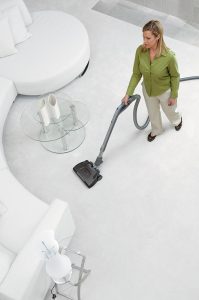Why Buy a Central Vac?
About Central Vac
 Central vacuums systems are built-in vacuums that link a hose and electric power brush to a central power unit with a collection canister. Special pipe is installed through interior walls, crawl spaces, attics or basements to connect the power unit with low-volt wall inlets.
Central vacuums systems are built-in vacuums that link a hose and electric power brush to a central power unit with a collection canister. Special pipe is installed through interior walls, crawl spaces, attics or basements to connect the power unit with low-volt wall inlets.
A central vacuum system features three basic components
- power unit
- piping system and inlets. Inlets are the connections in the wall where you plug in the hose—usually one inlet for every 750 square feet of living space
- A hose, attachments and cleaning tools
The power unit that includes the system motor and collection receptacle is usually in a garage, basement or utility room. The motor provides up to five times the cleaning power of a conventional vacuum. And, because the power unit is outside the living area, it does not exhaust inside the house to stir up more dust, dirt and allergens.
